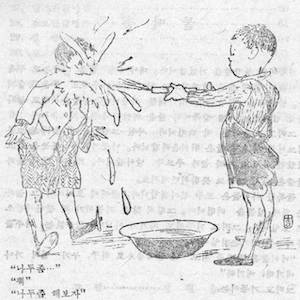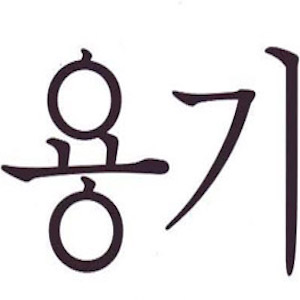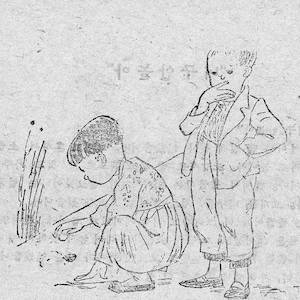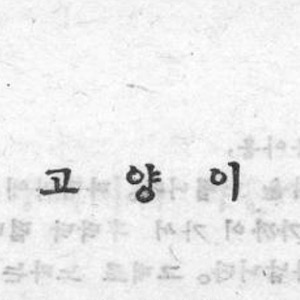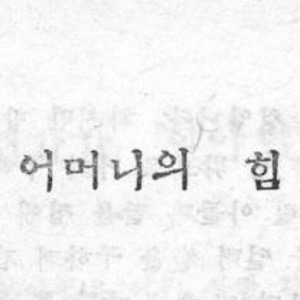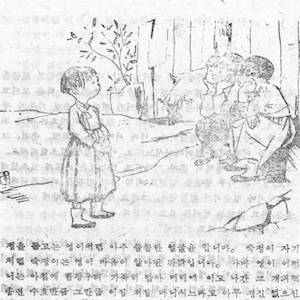Source Collection: Korean Colonial-Era Children’s Literature
Overview
Children's literature can reveal a great deal about the time and place in which it was written. These stories from Korea published in 1946 provide insights into ideas about childhood, play, gender, family and even national identity the newly independent and not yet divided nation. Each story is provided in Korean and with an English translation provided by undergraduate students in Prof. Teresa Michals's English 202 course at George Mason University Korea.
Essay
Known as the “liberation space,” 1945 – 1950 was an exuberant time for Korean national identity. Korean artists and intellectuals flourished in a country newly free from Japanese colonial occupation, but not yet divided by force into North and South. With very few material resources, Korean publishers produced brilliant pamphlet-like works commemorating Korean resistance to colonialism, debating left and right-wing paths for the country’s future, and exploring the power of traditionalist, modernist, and internationalist art.
The first half of the twentieth century was also a key time in the development of Korean ideas about childhood. In this period, Korean intellectuals popularized the word "eorin-i" for “child.” Rather than seeing children as small workers whose role was to contribute to the survival of their family as best they could, these progressive writers imagined childhood as a key period of psychological development, one that required parents to invest in special resources such as children’s literature.
In December of 1946, Chŏngŭm Publishing Company devoted its scarce and precious means to printing the Chosŏn Juvenile Literature series, which included Grapes and Beads, a collection of stories for children written by Hyeon Tok. The series stands out from the publisher’s works aimed at adults. It reminds us that societies that care a great deal about their future, as Korea cared in 1946, also tend to care a great deal about children’s literature. Although children’s literature often praises the idea that children are more natural and free than are adults, it is at its core a socializing project, one that represents adult ideals and contains strong ideological messages about identity, family, and society.
The stories' author, Hyŏn Tŏk, was a committed socialist who went North at the division of Korea. He wrote Grapes and Beads’s thirty-five stories in Korean under Japanese colonial occupation, his choice of language itself an assertion of Korean national identity.
Aimed at an audience of affluent, book-buying families in Seoul, Grapes and Beads realistically describes the daily lives of children in the poorer countryside with affection and respect. That is, in addition to being a new consumer good used in urban families’ emerging culture of childhood, the book also offers a glimpse of children’s lives in less wealthy settings. These interlocking stories feature a neighborhood group of young girls and boys, and include traditional Korean gender roles, foodways, games, and clothing. Hyŏn Tŏk recognizes both the ways that economic inequality and colonial rule frame these children’s lives, and the power of the children’s own personal resilience and imagination. Chŏng Hyŏn-ung drew the illustrations on the book cover and on the title page. Hyŏn Tŏk was eventually executed by the North Korean government.
Primary Sources
Bibliography
Dafna Zur, Figuring Korean Futures: Children’s Literature in Modern Korea, Stanford University Press, 2017.
Scott Swarner, “Between Liberation Space and Time of Need, 1945-1950: An Exhibition of Rare Literary Works from the Korean Collection of the University of Washington Libraries,” Exhibit Essay:
https://content.lib.washington.edu/koreanweb/essay.html
Credits
Teresa Michals received her Ph.D. from the Johns Hopkins University and teaches courses on the history of children's literature, nineteenth-century and late eighteenth-century literature, and composition. Her research and teaching focus on changing ideas about age, identity, bodies, and fiction. She has published articles in journals such as Nineteenth-Century Literature, Eighteenth-Century Studies, NOVEL, Studies in Eighteenth-Century Culture, and Disability Studies Quarterly, as well as essays in the edited collections The Nineteenth-Century Child and Consumer Culture (Ashgate Press) and Literary Cultures and 18th-Century Childhoods (Palgrave). Her first book is For Adult Audiences: The Child, The Adult, and the English Novel (Cambridge, 2014), and her second, Lame Captains and Left-Handed Admirals: Other Amputee Officers in Nelson's Navy, (University of VA Press, 2021).
Dr. Michals would additionally like to Ms. Ruba Sadi, Public Services Coordinator, UW Libraries Special Collection, for help securing permission to use this source; my student translators at George Mason University, Korea; and my colleagues at George Mason, Korea, Assistant Professor Sang Mee Oh and Assistant Professor Eunhee Seo, for their insightful work with these student translations.
